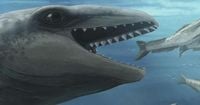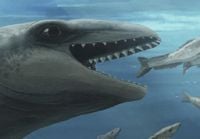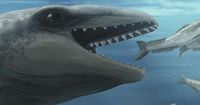On a windswept stretch of Australia’s Victoria coastline, a discovery millions of years in the making has finally made its splash. Scientists have unveiled a new species of ancient whale, Janjucetus dullardi, after a painstaking process that began with a sharp-eyed fossil hunter and ended with a publication in the Zoological Journal of the Linnean Society on August 15, 2025. The find is not just a scientific milestone—it’s a story of obsession, chance, and a creature as strange as any conjured by imagination or, as some put it, by a Pokémon designer.
The fossil in question, dating back 25 million years, was discovered in 2019 at Jan Juc Beach, a fossil-rich site that has become something of a mecca for paleontologists hoping to unravel the mysteries of whale evolution. According to the Associated Press, the partial skull, complete with ear bones and teeth, belonged to a juvenile whale with features that defy expectations: bulging eyes the size of tennis balls, a shark-like snout, and a mouthful of fearsome teeth. Despite being small enough to fit in a single bed, this little predator was no gentle giant.
“It was, let’s say, deceptively cute,” Erich Fitzgerald, senior curator of vertebrate paleontology at Museums Victoria Research Institute and one of the paper’s authors, told the Associated Press. “It might have looked for all the world like some weird kind of mash-up between a whale, a seal and a Pokémon but they were very much their own thing.”
The new species, Janjucetus dullardi, is now only the fourth identified member of the mammalodontids, a group of early whales that roamed the oceans during the Oligocene Epoch, roughly between 34 and 23 million years ago. This period marks a pivotal moment in whale history, about halfway through their known evolutionary journey. These ancient creatures, unlike today’s filter-feeding baleen whales, were formidable predators, growing up to three meters (about 10 feet) in length and sporting jaws built for hunting rather than grazing.
Fitzgerald described the evolutionary oddity of Janjucetus dullardi’s family tree: “They may have had tiny little nubbins of legs just projecting as stumps from the wall of the body.” But, as he noted, without a more complete skeleton, that tantalizing detail remains a mystery. The discovery of even a partial skull with enough preserved detail to confirm a new species is, in itself, a rare event—almost miraculous, given the odds stacked against fossilization in the ocean’s ever-changing environment.
The man behind the find is Ross Dullard, an amateur fossil hunter whose lifelong passion finally paid off in spectacular fashion. “It’s literally been the greatest 24 hours of my life,” Dullard said, reflecting on the moment the discovery was officially recognized. After the news broke, the school principal walked into work to a hero’s welcome, with “high fives coming left, right and center.” For six years, Dullard’s friends and family endured his single-minded focus on the fossil, but now, with the species bearing his name, it’s all been worth it.
Dullard’s routine low-tide hunt at Jan Juc Beach took a dramatic turn when he spotted something black jutting out from a cliff face. A gentle prod dislodged a tooth—clearly not from a dog or a seal. “I thought, geez, we’ve got something special here,” he recalled. He snapped photos and sent them to Museums Victoria, where Fitzgerald immediately suspected the significance of the find. The confirmation process was anything but simple, given the rarity of mammalodontid fossils in Australia. In fact, this is the first such species identified in the country since 2006 and only the third ever recorded there.
Why are these discoveries so few and far between? As Fitzgerald explained to the Associated Press, “Cetaceans represent a fairly miniscule population of all life.” The forces of erosion, scavengers, and relentless ocean currents make the preservation of whale skeletons a game of chance. “It’s only the chosen few, the vast minority of all whales that have ever lived and died in the oceans over millions of years, that actually get preserved as fossils,” he said.
Yet, when such fossils do surface, they offer a rare window into the deep past. The Janjucetus dullardi specimen, with its unique combination of features, is helping scientists fill in the gaps about how whales transitioned from fearsome predators to the gentle filter-feeders we know today. These insights extend beyond mere curiosity—they inform our understanding of how ancient cetaceans adapted to warmer oceans, a topic of growing relevance as today’s marine life faces the pressures of climate change.
The story doesn’t end with scientific papers and museum displays. Dullard, ever the enthusiast, planned to mark the occasion with a fossil party, complete with cetacean-themed games and whale-shaped treats in jello. “That’s taken my concentration for six years,” he admitted. “I’ve had sleepless nights. I’ve dreamt about this whale.”
News of the discovery made waves far beyond the scientific community. According to a gallery report published on August 15, 2025, the quirky appearance of Janjucetus dullardi—a blend of cartoonish charm and predatory menace—captured the imagination of the public. The fossil has even been described as having a “Pokémon-like face and predator bite,” a testament to its unique place in both science and pop culture.
Jan Juc Beach, already known as a cradle for some of the oddest whales in history, has cemented its reputation as a hotspot for paleontological breakthroughs. Each new find there adds a piece to the puzzle of whale evolution. The partial skull of Janjucetus dullardi, with its combination of preserved ear bones and teeth, is a reminder of the ocean’s hidden stories—and of the persistence required to uncover them.
As researchers continue to study the fossil, their work promises to shed more light on how early whales lived, hunted, and adapted to their changing world. For now, though, the tale of Janjucetus dullardi stands as a testament to curiosity, luck, and the enduring allure of the unknown. Sometimes, all it takes is a sharp eye, a bit of patience, and a willingness to dream about what lies beneath our feet—or, in this case, buried in the cliffs of a quiet Australian beach.






